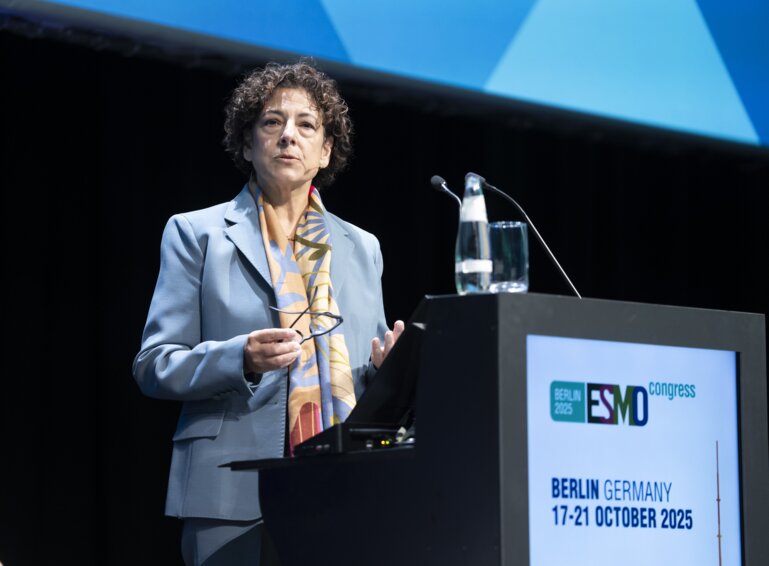Results from the monarcHER and KATE2 trials presented
Non-chemotherapy-based combination therapies may play a possible role for the treatment of women with HER2-positive (HER2+) tumours, as by selectively targeting a specific group of patients, there is a greater opportunity to achieve control of the disease. Two studies presented yesterday—monarcHER and KATE2—add further insight into the future treatment of HER2+ breast cancer but, despite the promises, the combination therapy remains, for now, a potential advance.The combination of abemaciclib, trastuzumab and fulvestrant prolonged median progression-free survival (PFS) compared with trastuzumab plus chemotherapy (8.3 months versus 5.7 months; hazard ratio 0.67; p=0.025) in postmenopausal, pretreated women with HR+, HER2+ advanced breast cancer in the monarcHER trial (Abstract LBA23).
The monarcHER trial met its primary endpoint and reported objective response rates of 35.4% for the combination of abemaciclib, trastuzumab and fulvestrant and 22.8% for trastuzumab plus chemotherapy. In this phase II trial involving 237 patients, omission of fulvestrant removed the benefit of the triple combination over trastuzumab plus chemotherapy (hazard ratio 0.94). There were no new safety signals but thrombocytopenia (10.3% versus 2.8%) and diarrhoea (9.0% versus 2.8%) were more common with the triple combination compared with trastuzumab plus chemotherapy. In the phase II KATE2 trial, adding atezolizumab to trastuzumab emtansine (T-DM1) was reported to provide a 45% reduction in the risk of death compared with T-DM1 plus placebo in patients with PD-L1-expressing HER2+ advanced breast cancer that had progressed after trastuzumab and a taxane. Intention-to-treat analysis of this phase II trial in 202 patients revealed that median overall survival (OS) times were not reached in either arm and 1-year OS rates with and without atezolizumab were virtually identical (89.1% and 89.0%, respectively) (Abstract 305O).In a subgroup of 84 patients with PD-L1-positive disease, 1-year OS rates were 94.3% with atezolizumab plus T-DM1 and 87.9% with T-DM1 plus placebo, with an OS hazard ratio of 0.55. The findings support the PFS results of KATE2 reported earlier in 2019, with a numerical benefit limited to patients with PD-L1-expressing disease.
"KATE2 adds to our knowledge base that in the metastatic breast cancer setting—and hopefully, in the future, for early disease—immunotherapy is becoming an increasingly useful combination partner for HER2-directed therapies in HER2-overexpressing disease,” says Dr Luca Gianni from IRCCS Ospedale San Raffaele, Milan, Italy. He adds to what has become a common call for new therapies: more investigation to identify the patients most likely to benefit from treatment with a CDK 4/6 inhibitor or a checkpoint inhibitor, and those who could be spared this additional therapy.
The two presented studies provide a number of important considerations in this setting. "The results from are a final conclusion that HER2+, HR+ tumours require different therapeutic strategies to HER2+, HR-negative tumours. This is in line with what we already know from other trials: that combining effective blockade of HER2 and the hormone dependence of these tumours can enhance antitumour activity,” comments Gianni. "Given the overlap in the signalling pathways involved, the powerful effect of adding abemaciclib to treatment should not come as a surprise, but it is reassuring that the clinical effects reflect the biological predictions.” There is likely to be little that separates different CDK 4/6 inhibitors in terms of efficacy and that while adverse events with these agents are generally manageable—and certainly less problematic than those with chemotherapy—differences in toxicity profiles may be one of the aspects guiding the choice of agent in the clinical setting.
According to Gianni, the main drawback of the KATE2 trial is the small size of the subgroup of patients with PD-L1-expressing disease. "Although survival appeared to be better in these patients, it is not possible to draw conclusions based on such low patient numbers at this time,” he says. "Whether the findings will be confirmed in a larger population remains to be seen. We know that the activity of the PD-1 checkpoint inhibitor pembrolizumab is enhanced in PD-L1-positive disease, so perhaps it is something we will see in future studies with atezolizumab, although effects may be influenced by the more restricted target of PD-L1 compared with PD-1 inhibitors.”
ESMO Congress 2019 abstracts:
- LBA23 - MonarcHER: A randomized phase II study of abemaciclib plus trastuzumab with or without fulvestrant versus trastuzumab plus standard-of-care chemotherapy in women with HR+, HER2+ advanced breast cancer (ABC)
- 305O - Overall survival (OS) in KATE2, a phase II study of programmed death ligand 1 (PD-L1) inhibitor atezolizumab (atezo)+trastuzumab emtansine (T-DM1) vs placebo (pbo)+T-DM1 in previously treated HER2+ advanced breast cancer (BC)






